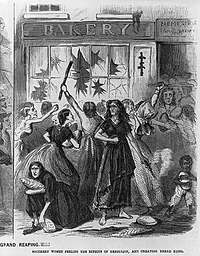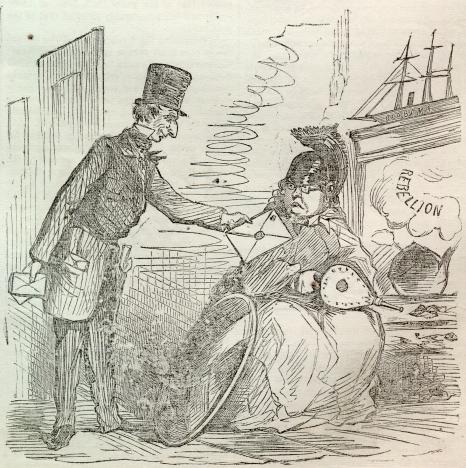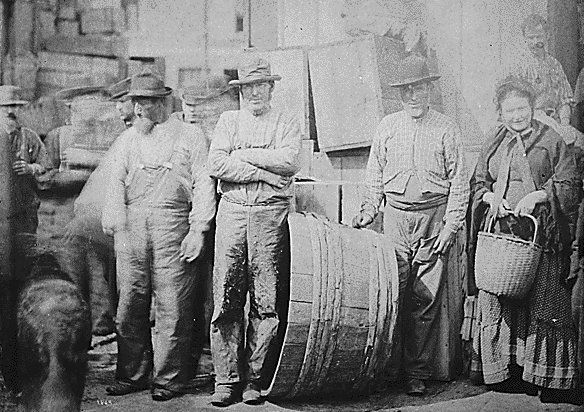
From the Nation Magazine, "Restless Confederates," by Eric Foner, on 14 July 2010 -- The bicentennial of Abraham Lincoln's birth has come and gone, and with it a flood of books about the sixteenth president. But the sesquicentennial of the Civil War now looms on the horizon, promising its own deluge of books of every size, shape and description. We will be fortunate indeed if in sheer originality and insight they measure up to Confederate Reckoning and The Long Shadow of the Civil War, new works by Stephanie McCurry and Victoria Bynum, respectively, on the Confederate experience.
Most scholarly history on the Confederacy has been shaped, implicitly or explicitly, by a desire to explain Southern defeat. Devotees of the Lost Cause insist that gallant Southern soldiers inevitably succumbed to the Union's overwhelming advantages in manpower and economic resources. The stronger side, however, does not always win a war, as the United States learned in Vietnam. This fact has led historians to try to locate internal causes for the failure of the quest for Southern independence. They have identified such culprits as poor political leadership, excessive individualism, desertion from the army by non-slaveholding soldiers, waning enthusiasm for the war among upper-class white women and disaffection among the slaves.
McCurry and Bynum are less interested in why the South lost—although their books shed light on this question—than in the social and political consequences of how it conducted the war. Taken together, they show how the effort to create a slaveholders' republic sundered Southern society and changed the contours of Southern politics. The subtitle of McCurry's book—"Power and Politics in the Civil War South"—is surely meant to be ironic. Most readers will no doubt expect another study of Jefferson Davis's administration or the battle between advocates of states' rights and central control. But McCurry challenges us to expand our definition of politics to encompass not simply government but the entire public sphere. The struggle for Southern independence, she shows, opened the door for the mobilization of two groups previously outside the political nation—white women of the nonslaveholding class and slaves.
McCurry begins by stating what should be obvious but is frequently denied, that the Confederacy was something decidedly odd in the nineteenth century: "an independent proslavery nation." The Confederate and state constitutions made clear that protecting slavery was their raison d'être. Abandoning euphemisms like "other persons" by which the US Constitution referred to slaves without directly acknowledging their existence, Confederates forthrightly named the institution, erected protections around it and explicitly limited citizenship to white persons. McCurry implicitly pokes holes in other explanations for Southern secession, such as opposition to Republican economic policies like the tariff or fear for the future of personal freedom under a Lincoln administration. Georgia, she notes, passed a law in 1861 that made continuing loyalty to the Union a capital offense, hardly the action of a government concerned about individual liberty or the rights of minorities.

The Confederacy, McCurry writes, was conceived as a "republic of white men." But since of its 9 million people more than 3 million were slaves and half of the remainder disenfranchised white women, the new nation faced from the outset a "crisis of legitimacy." However much the law defined white women as appendages of their husbands, entitled to protection but not a public voice, and slaves simply as property, Southern leaders realized early that they would have to compete with the Union for the loyalty of these groups, treating them, in effect, as independent actors. The need to generate consent allowed "the Confederate unenfranchised" to step onto the stage of politics, with their own demands, grievances and actions.
McCurry's chapters delineating the political emergence of poor white women constitute the most dramatic and original parts of Confederate Reckoning. She makes clear that introducing gender as a category of analysis changes the definition of politics and power, but simultaneously warns against considering "woman" a unitary identity independent of class. All Confederate women struggled to cope as their loved ones were drawn off into the army, many never to return. Women of all classes called upon the state for assistance during the war. But when wealthy women made demands on the Confederate government, they did so as members of a national elite.

Poorer women forged a different political identity. They spoke the language not of Southern nationalism or upper-class identity but of family and community. They described themselves as soldiers' wives and invoked what McCurry calls a "politics of subsistence." Lacking the aid of slave labor, they found that the absence of their husbands from their previously self-sufficient farms made it impossible to feed themselves and their children. As the war progressed and the economic situation deteriorated, they flooded Confederate authorities with petitions seeking assistance, not as charity but as a right. In demanding aid from local, state and national governments, these women articulated a new vision of themselves as citizens with legitimate claims upon the state. Eventually, poor women took to the streets in food riots in major Confederate cities, the most dramatic example of their emergence as a political force.
The policies of the Confederate government and the actions of slaveowning planters exacerbated these women's sense of grievance. The Confederate Congress enacted the twenty-Negro exemption, allowing one adult man to remain at home for every twenty slaves on a plantation in order to forestall slave resistance. Policies like impressment and the tax-in-kind, which allowed the army to appropriate farm goods, were applied much more rigorously against poorer Southerners than wealthy ones. Planters showed little interest in assisting their suffering neighbors and resisted calls by Confederate authorities to grow edible crops instead of cotton. "The rich people about here there hearts are of steel," one Virginia woman wrote to Jefferson Davis. Indeed, planters' unwillingness to sacrifice self-interest for the common good is a recurring theme of Confederate Reckoning. Having created a nation based on slavery, they proved reluctant to provide blacks for military labor, fearing this would interfere with their hold on their slave property. "You cheerfully yield your children to your country," one antiplanter broadside asked, "how you refuse your servants?"

Later generations would create the myth of the ardently patriotic Southern woman. Contemporaries knew better. The agitation of poor women, McCurry shows, alarmed Southern officials and directly affected Confederate policy. Politicians could not ignore the pleas of soldiers' wives. Congress moved to exempt poor families from taxation. Governors like Zebulon Vance of North Carolina and Joseph Brown of Georgia distributed supplies to needy families. By the end of the war, McCurry writes, the Confederacy had created a significant "welfare system." Georgia spent more money on relief in one year than Massachusetts (a state with a significant poor population) did during the entire war.
In the second half of Confederate Reckoning, McCurry turns to the actions of slaves during the war. Here she covers more familiar ground but still manages to offer striking new insights. It is now widely recognized that the actions of slaves who ran away to Union lines helped to put the slavery issue on the agenda of the Lincoln administration, and that by serving in the Union army black soldiers staked a claim to citizenship in the post-bellum world. Most slaves, however, lived out the war behind Confederate lines. The government they had to deal with, McCurry points out, was Davis's, not Lincoln's.

From the outset, McCurry shows, slaves carefully followed national politics and the course of the war. Even before Lincoln's election, the planter Charles Manigault noted, his slaves had "very generally got the idea of being emancipated when 'Lincon' comes in." Once the war began, slaves took every opportunity to aid Union forces and resist the demands of their owners. McCurry describes Manigault's plantations as being "in a state of barely suppressed insurrection." How to characterize slaves' actions has long posed a challenge for historians. W.E.B. Du Bois wrote of a "general strike" in the Confederacy. McCurry goes even further, using the phrase "a massive slave rebellion." This seems an exaggeration. But she is on firm ground when she insists that a battle ensued between North and South for slaves' "political allegiance."
Like the actions of white women, those of slaves strongly affected public policy, in ways that weakened Southern unity and wartime mobilization. Unrest on the plantations led to the twenty-Negro exemption, which, in turn, heightened discontent among nonslaveholding farm families. Slaves' propensity to escape when near Union lines explains why planters resisted their use as military laborers, weakening the war effort. Planter resistance to the army's impressment of slave labor drew support from state governments that tried to undermine the policies of the Davis administration. The well-known battles over states' rights in the Confederacy, McCurry convincingly argues, were really arguments over whether the needs of the national government should take precedence over the property rights of slaveholders.

The struggle over slave impressment offered a prelude to the well-known debate of 1864–65 over the enrollment of slaves in the Confederate army. In the Emancipation Proclamation Lincoln had authorized black enlistment, and by war's end some 200,000 black men had served in the Union army and navy. As the Confederacy's situation worsened, military leaders including Robert E. Lee called for enrolling blacks. Lee went so far as to propose coupling enlistment with a plan for "gradual and general emancipation." This was far more than the Confederate Congress could stomach. In March 1865, it finally authorized slave enlistment, in a law that made no mention of freedom. In his implementation order, however, Jefferson Davis promised freedom to those who agreed to serve. In other words, Davis acknowledged that slaves were able to make independent decisions and that their loyalty had to be won, not simply commanded.
McCurry correctly points out that enlisting blacks in the Confederate army and offering them freedom did not necessarily mean the end of slavery. Both the British and the Americans had used slave soldiers in the War of Independence, yet slavery survived. It did so as well in the West Indies, where the British raised and freed slave regiments. Had the Confederacy emerged victorious, slavery would certainly have continued. In any event, a few days before the war ended, two companies of Confederate black soldiers from Richmond were sent to the front. Most of these men had already been impressed to work in a Confederate hospital; whether they were truly volunteers may be doubted. Certainly, as McCurry makes clear, the idea that legions of slaves fought for the slaveholders' republic—a notion propagated by neo-Confederate organizations and widely disseminated on the Internet—is a myth.

Confederate Reckoning offers a powerful new paradigm for understanding events on the Confederate home front. Unfortunately, the book's structure to some extent stands at cross-purposes with its argument. Its two parts are not really integrated. White women pretty much disappear from the second half of the narrative, and there is little attention to how the political mobilization of slaves and white women of the nonslaveholding class, so expertly delineated, intersected. Moreover, a full account of how the war politicized previously marginalized groups and heightened tensions within Southern society would require attention to a group neglected in this study—disaffected white men from the nonslaveholding class.
McCurry explains her decision not to write about these white men by pointing out that, thanks to studies of desertion from the Confederate army, we already "know a great deal" about them. But as Victoria Bynum notes in The Long Shadow of the Civil War, the "communities of dissent" that emerged in the Civil War South involved both men and women. Bynum studies three areas of disaffection within the Confederacy: the "Quaker belt" of central North Carolina; Jones County in southern Mississippi's Piney Woods; and the Big Thicket of East Texas. These localities lay outside the main plantation region and were populated mostly by nonslaveholding families. The three regions shared more than a similar demography. Many of the Mississippi Unionists had relatives in North Carolina, and some of the Texas guerrillas had emigrated from Jones County.

Bynum's subjects "hated the Confederacy" and in some cases took up arms against it. In these areas, bands of deserters plagued the Confederate war effort, and an internal civil war took place that pitted neighbor against neighbor. Unionist activity rested on extended family networks. The wives of deserters and draft dodgers acted not as Confederate soldiers' wives but as anti-Confederate cadres. They threatened public officials; stole from wealthier neighbors; and provided shelter, food and information to male relatives hiding out in the woods.
Bynum, whose well-regarded book on Jones County, The Free State of Jones: Mississippi's Longest Civil War, dispelled the idea that it actually "seceded" from the Confederacy, clearly sympathizes with her subjects. Some of her ancestors, she writes, were among these lower-class Unionists. But she avoids over-romanticization. Bill Owens, the leading Unionist guerrilla in North Carolina, she notes, was a cold-blooded killer. But heinous acts were not limited to one side. Confederate soldiers tortured Owens's wife to gain information about his whereabouts. Local militia units mistreated Unionist women and children. Owens himself, after his capture toward the end of the war, was taken from his jail cell by unknown parties and murdered.

Bynum's book is not so much a narrative history as a series of discrete, overlapping and somewhat disjointed case studies. But it adds a dimension to McCurry's far broader study by taking the story beyond the end of the Civil War to trace the long-term legacy of pro-Union activism. One chapter shows how family traditions of dissent survived in new forms as veterans of the "inner Civil War" and their descendants joined the biracial Republican Party during Reconstruction and emerged as leaders of Populism in the 1890s and the Socialist Party of Eugene Debs. The legacy of violent white supremacy also survived. The wartime Confederate militia was succeeded by the Ku Klux Klan after the war and "whitecappers" around the turn of the century.
Bynum invokes court cases to track the shifting political fortunes of the postwar South. In one North Carolina county, the members of an extended family challenged the right of a female relative to inherit land on the grounds that she had African ancestry. In 1892 a court ruled against the woman, and she lost the farm she and her late husband had tilled for two decades. Honor, supposedly a central characteristic of white Southern culture, seems to have been in short supply after the Civil War.

One of the more fascinating figures Bynum discusses is Newt Knight, the leader of an armed band of Unionists in Jones County who lived with a black woman and became "the patriarch of an extensive mixed-race community." Bynum relates his long, unsuccessful campaign for monetary compensation from the federal government for his wartime activities. She also explores the fate of his mixed-race children and grandchildren. Some identified as people of color; some disappeared into white society. One descendant, David Knight, served in the Army during World War II, married a white woman in 1946 and two years later was convicted in Mississippi of the crime of miscegenation. The Confederacy certainly cast a long shadow. (Nation Magazine)
Stephanie McCurry: War, Slavery, and Emancipation from The Gilder Lehrman Institute on Vimeo.


No comments:
Post a Comment